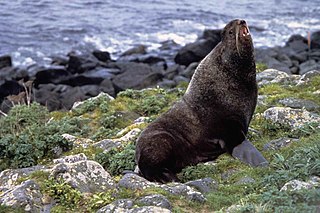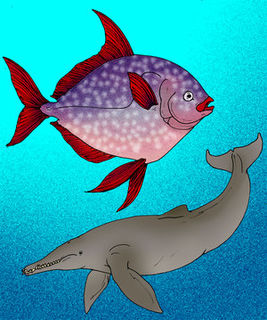
The earless seals, phocids or true seals are one of the three main groups of mammals within the seal lineage, Pinnipedia. All true seals are members of the family Phocidae. They are sometimes called crawling seals to distinguish them from the fur seals and sea lions of the family Otariidae. Seals live in the oceans of both hemispheres and, with the exception of the more tropical monk seals, are mostly confined to polar, subpolar, and temperate climates. The Baikal seal is the only species of exclusively freshwater seal.

Fur seals are any of nine species of pinnipeds belonging to the subfamily Arctocephalinae in the family Otariidae. They are much more closely related to sea lions than true seals, and share with them external ears (pinnae), relatively long and muscular foreflippers, and the ability to walk on all fours. They are marked by their dense underfur, which made them a long-time object of commercial hunting. Eight species belong to the genus Arctocephalus and are found primarily in the Southern Hemisphere, while a ninth species also sometimes called fur seal, the northern fur seal, belongs to a different genus and inhabits the North Pacific.

An eared seal or otariid or otary is any member of the marine mammal family Otariidae, one of three groupings of pinnipeds. They comprise 15 extant species in seven genera and are commonly known either as sea lions or fur seals, distinct from true seals (phocids) and the walrus (odobenids). Otariids are adapted to a semiaquatic lifestyle, feeding and migrating in the water, but breeding and resting on land or ice. They reside in subpolar, temperate, and equatorial waters throughout the Pacific and Southern Oceans and the southern Indian and Atlantic Oceans. They are conspicuously absent in the north Atlantic.

Sea lions are pinnipeds characterized by external ear flaps, long foreflippers, the ability to walk on all fours, short, thick hair, and a big chest and belly. Together with the fur seals, they comprise the family Otariidae, eared seals, which contains six extant and one extinct species in five genera. Their range extends from the subarctic to tropical waters of the global ocean in both the Northern and Southern Hemispheres, with the notable exception of the northern Atlantic Ocean. They have an average lifespan of 20–30 years. A male California sea lion weighs on average about 300 kg (660 lb) and is about 2.4 m (8 ft) long, while the female sea lion weighs 100 kg (220 lb) and is 1.8 m (6 ft) long. The largest sea lion is Steller's sea lion, which can weigh 1,000 kg (2,200 lb) and grow to a length of 3.0 m (10 ft). Sea lions consume large quantities of food at a time and are known to eat about 5–8% of their body weight at a single feeding. Sea lions can move around 16 knots in water and at their fastest they can reach a speed of about 30 knots. Three species, the Australian sea lion, the Galápagos sea lion and the New Zealand sea lion, are listed as endangered.

Pinnipeds, commonly known as seals, are a widely distributed and diverse clade of carnivorous, fin-footed, semiaquatic, mostly marine mammals. They comprise the extant families Odobenidae, Otariidae, and Phocidae. There are 33 extant species of pinnipeds, and more than 50 extinct species have been described from fossils. While seals were historically thought to have descended from two ancestral lines, molecular evidence supports them as a monophyletic lineage. Pinnipeds belong to the order Carnivora; their closest living relatives are bears and the superfamily of musteloids, having diverged about 50 million years ago.

The northern fur seal is an eared seal found along the north Pacific Ocean, the Bering Sea, and the Sea of Okhotsk. It is the largest member of the fur seal subfamily (Arctocephalinae) and the only living species in the genus Callorhinus. A single fossil species, Callorhinus gilmorei, is known from the Pliocene of Japan and western North America.
The Pleistocene bush dog is an extinct canid species in the genus Speothos from the Late Pleistocene. It was a relative of the extant bush dog. When compared to the bush dog, S. pacivorus had an overall larger body size, a straighter radial shaft and a double-rooted second lower molar.

Enaliarctos is an extinct genus of pinniped, and may represent the ancestor to all pinnipeds. Prior to the discovery of Puijila, the five species in the genus Enaliarctos represented the oldest known pinniped fossils, having been recovered from late Oligocene and early Miocene strata of California and Oregon.
The San Diego Formation is a geologic formation in southwestern San Diego County in southern California, and northwestern Baja California (México).
Douglas Ralph Emlong was an amateur fossil collector from the Oregon Coast in the northwestern United States. His collections contributed to the discovery and description of numerous extinct marine mammal species, many of which are ancestral to extant groups. Described as an 'indefatigable' fossil collector with 'Promethian prowess in discovery of unprecedented vertebrate fossils', he contributed substantially to the field from the age of fourteen. The ancestral pinniped Enaliarctos emlongi was named in his honor by Annalisa Berta in 1991.

Aivukus is an extinct genus of walrus from the Miocene.

Orycteocetus is an extinct genus of sperm whale from the Miocene of the northern Atlantic Ocean.

Waipatia is an extinct genus of whale from the late Oligocene (Chattian) of New Zealand.

Valenictus is an extinct genus of Odobenidae from the Pliocene of California.

Pliophoca is an extinct genus of seal in the family Phocidae.
Pachyphoca is an extinct genus of earless seals from Neogene marine deposits in the northern part of the Paratethys basin.
Homiphoca is an extinct genus of earless seals from the Pliocene of South Africa.
Leopardus vorohuensis is an extinct species of feline. Fossils of the species were found in the Vorohué Formation of Argentina and dated to the Uquian age of the early middle Pleistocene. It is the earliest known cat of the ocelot lineage of neotropical cats.

Callorhinus gilmorei is an extinct species of fur seal that lived in Japan and western North America during the Pliocene and Early Pleistocene.













